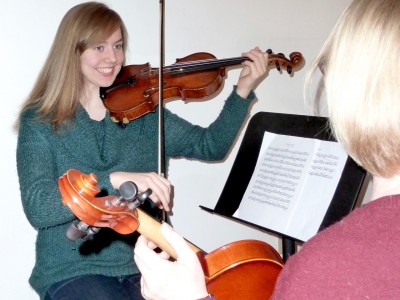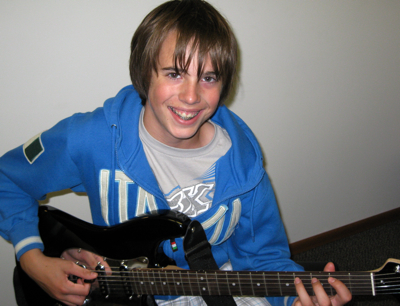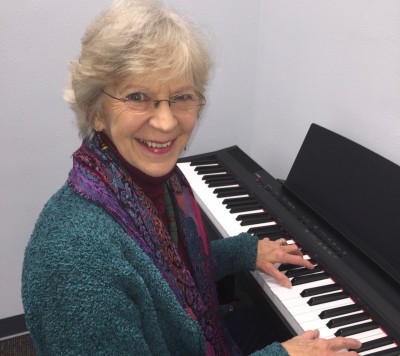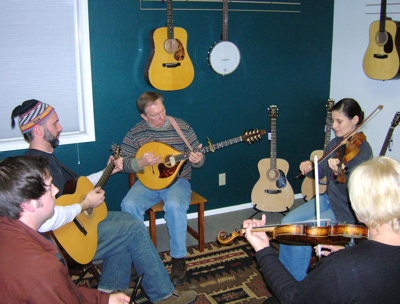So there I was, a soft-spoken, awkwardly tall sixth-grader sitting amongst a sea of children on the floor of the multi-purpose room. We were there to see a demonstration to assist in our decision of whether to join band or orchestra that year. Standing in front of us were the resident music teachers. Their rivalry was palpable as they paraded each instrument about in hopes of signing the most recruits. The band teacher proceeded to hold up a series of twisted metal objects, putting each one up to his puffed-out cheeks until he was red in the face. These instruments were loud and commanding, but even with their shiny lacquer finishes and abundance of intricate buttons, none of the band instruments appealed to me. They sounded too bossy. I turned my attention to the orchestra teacher and thought how graceful the world of stringed instruments looked and sounded. There was no question in my mind. I was destined to be an orch dork.
I quietly listened as she demonstrated each of the four instruments, and made what – to a 12-year-old – was an informed decision. That night at the dinner table I announced to my parents, “I’m going to play the bass.” You see, I wanted to play the bass because it was the biggest (and as a 5’9’’ preteen girl, proximity in size was a major deciding factor.) After nearly choking on his stewed carrots from laughing so hard, my dad wiped his eye and said, “You’re kidding, right? We’re not chauffeuring that thing around.” “Pick something smaller, dear.” my mom chimed in. So I moved down one size to the slightly more portable cello, and although my musical endeavors brought me to learn all of the instruments in the orchestral family and beyond, the cello is forever seated at the top of the totem pole.
But not everyone can expect to find a lifelong instrument for themselves or their child through such happenstance. There are numerous aspects of ownership and operation to consider before taking the plunge and buying or renting an instrument. So how do you know which instrument is right for you or your child? What sort of musical experiences can be expected for each instrument? Well, let’s take a look.
Violin – By far the instrument that comes to the most minds when considering joining the orchestra, and for good reason. They’re small and therefore portable, the instruments and supplies are the most affordable of the bunch, and violins unquestionably get to play more interesting melodies more of the time than any other instrument. This is just the nature of the beast, and it translates into a myriad of other reasons to choose the violin.
• Since they are the least expensive to obtain and maintain, it is the obvious pick for a student who is uncertain about what they want to play or how long they want to play it.
• Violins can be taken on the bus and in most cases fit easily into a locker at school.
• Violins almost always get the melody (fun) parts in orchestral music.
• There is a wide variety of music that caters to the violin, including classical, folk, Irish, bluegrass, jazz, even hip-hop.
• Be sure that upon choosing the violin, your student is properly equipped with a shoulder rest. This makes holding the instrument easier, more comfortable, and more encouraging.
Viola – There is something to be said about the student who chooses to play viola. Some of the most interesting people I know are viola players. They tend to be laid back and content to exist in the background, without just being ‘one of the crowd.’ But shine the light on them and they really come alive. They’re similar to the Brahma kamal flower that only blooms at midnight once a year. There are different expectations one should have when choosing to play the viola.
• Violas, being slightly larger, are also slightly more expensive than violins. Additionally, the cost of viola supplies such and strings and shoulder rests are marginally higher than those of the violin. Keep in mind though, that these price differences are not astronomical.
• Violas can be taken on the bus and in most cases fit easily into a locker at school.
• Orchestral music for viola is an often overlooked factor. They tend to get supportive parts, harmonies, or off-beat rhythms. This can be rewarding in the beginning due to the fact that the parts are easy to play and there is a great sense of accomplishment. But violas tend to get stuck with these parts for quite some time. Well into high school. There is beautiful literature out there written for viola, but the amount of time it takes to get there can be discouraging to some students.
• Be sure that upon choosing the viola, your student is properly equipped with a shoulder rest. This makes holding the instrument easier, more comfortable, and more encouraging.
Cello – Ah, the cello. It’s hard not to be biased toward this sonorous instrument. I myself have put many a mile on my cello bow over the years. The range of the cello is closest to that of the human voice, and it has a broad, versatile sound that can evoke both joy and sadness in the same bow stroke. Here are some things to consider if your student is interesting in becoming a cellist.
• Cellos are too large to fit into a school locker and are not permitted on the bus.
• Since they are much larger than violins or violas they are also much more expensive. They generally rent for twice as much, and ultimately cost two to three times as much as the smaller string instruments. Along with this, strings are markedly more expensive for cellos.
• Because of their size cellos are constantly getting bumped into things, and they require a certain awareness to avoid getting damaged.
• In my personal experience, cello players are the most likely to develop bad habits when it comes to technique. This is easily remedied by signing up for private lessons.
• Beginning orchestral music for cello has a fast learning curve. Since it is mostly long notes that support what the upper strings are playing, it is rewarding to be able to play your part and play your part well. Additionally, the rate at which cellos graduate to more technically difficult music is more agreeable than that of the bass or viola.
• When selecting an endpin rest, I recommend the strap version that attaches to the leg of the chair. The rubber doughnut kind tends to be just as slippery as not using one at all.
Bass – Last but not least, the bass. It’s the largest instrument in the string family, and by far the one that makes the biggest impression – on the pocketbook that is. Because they are the largest they’re going to be the most expensive. However, some schools offer loaner instruments to use for the school year for a reasonable price. Otherwise, you’ll have to rent (or buy!) one from a local shop. Not every music store is in the business of renting basses, so options are pretty limited. Other things to consider before choosing the bass:
• Basses are far too large to fit in a school locker (or many cars!) and they are not permitted on the bus.
• Be prepared to shell out if one of the strings breaks.
• Because of their size basses are constantly getting bumped into things, and they require a certain awareness to avoid getting damaged.
• Bass is fun to play in the very beginning. First of all, you get to play an instrument that is taller than you are. Also, the music is easy to learn and therefore is gratifying to play. But bassists beware, you’re going to be supporting the orchestra for a long time. If you dream of being in the spotlight, it’ll take quite a while to get there with a bass in tow.
I encourage all of you to support your child’s or your own interest and love of music. Part of this is making sure they have everything they need to enjoy their musical experience. Shoulder rests for violins and violas, endpin rests for cellos, rosin, strings, and music stands for home practice are all necessary supplies. Additionally, I would like to point out that when playing in a large group at school, the teacher simply doesn’t have the time to devote to the individual needs of each student. They are there as a guide, and so it is highly recommended that whichever instrument they choose, you sign your child up for private lessons outside of school. This will ensure that they get the most out of their instrument and that they develop proper posture and technique, which are the building blocks to becoming a great musician.





{ 0 comments… add one now }
You must log in to post a comment.